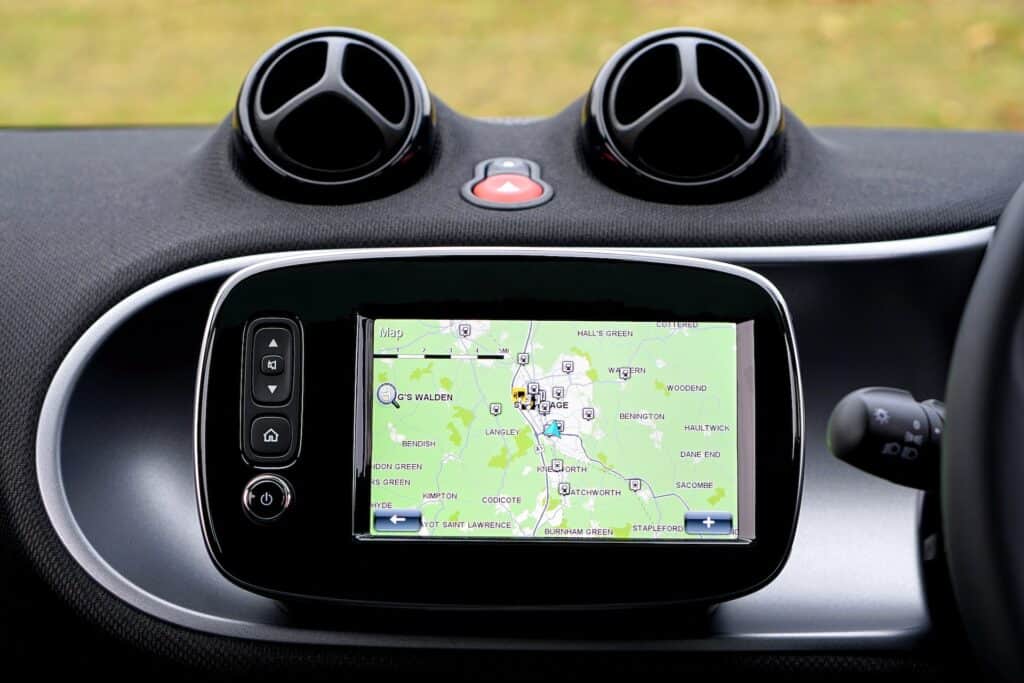What are Telematics Devices in Last-Mile Delivery?

Wise Systems

The use of telematics devices in last-mile delivery has come a long way in recent years, allowing vehicles to share information about driving behavior, locations, mechanical problems, and more. In short, telematics devices can now offer a wealth of information to improve how fleets operate.
This guide covers the following:
- What are Telematics Devices in Last-Mile Delivery?
- How Telematics Devices Work
- 5 Benefits of Telematics Devices for Last-Mile Delivery
- Challenges and Considerations for Telematics in Last-Mile Delivery
- Emerging Trends in Telematics
- Implementing Telematics Devices into Your Fleet
- Frequently Asked Questions
What are Telematics Devices in Last-Mile Delivery?

Telematics devices are used in last-mile delivery to help optimize routing, decrease delivery times, and gather important safety data from fleet vehicles. They’re beneficial in improving a fleet’s health, safety, and efficiency while reducing risks and costs associated with managing fleets.
How Telematics Devices Work in Last-Mile Delivery
Last-mile delivery businesses must keep up with demand while keeping customers happy with on-time, efficient deliveries. Check out our latest blog on fleet route optimization, and opportunities to transform last-mile delivery for your business. Read here! https://t.co/yBM63uApCo pic.twitter.com/l289WNIBDN
— Wise Systems (@goWiseSystems) March 7, 2023
Telematics devices can work differently, depending on what they’re designed to do, but are usually installed directly into fleet vehicles. Some telematics devices plug into a vehicle to gather mechanical and driving information, while others use satellite, cellular networks, or Bluetooth signals to pick up data.
These devices can gather information about:
- Mechanical problems affecting a vehicle
- Driver behavior, like quick acceleration, speeding, or hard braking
- Idling time
- Location and route mileage
- How much fuel is used per trip
Once a device collects information, that information is stored on the device and sent to a fleet management software hub for fleet managers to view. These systems may also have connected apps allowing drivers to view their collected data.
5 Benefits of Telematics Devices for Last-Mile Delivery

Companies offering last-mile delivery services can benefit from using telematics devices in their fleets, thanks to data about location, fuel consumption, and more. If you’re a last-mile operator looking to optimize deliveries, consider the following benefits of implementing telematics.
1. Vehicle Routing Optimization
With a telematics system in place, fleet managers can track each vehicle in real-time to plan and adjust routes. Telematics devices can detect potential hiccups in routes, like weather or traffic delays, based on how the vehicle travels, allowing managers to find an alternate route to keep deliveries on track.
The data collected from these devices also offers long-term benefits. Managers can use data from past weeks and months to identify trends, allowing them to adjust future routes for efficiency.
Book a demo today to discover how the Wise Systems delivery automation platform can help you optimize routes and improve fleet performance.
2. Risk Management
With multiple drivers on the road at any given time for last-mile delivery, the risk of an accident increases. Telematics devices pick up risky driving behaviors like speeding or hard braking, which can be key pieces of data for fleet managers to keep tabs on.
Additionally, insurance companies use this data to assess risk for insurance premiums.
3. Ensuring Safety Standards
Because telematics devices allow fleet managers to see how their drivers operate on the road, they offer important safety information to ensure that last-mile drivers meet safety standards set by their company.
For example, there may be a rule in place for vehicles not to travel more than 65 miles per hour, and a telematics device can detect if a driver continuously exceeds this limit.
4. Keeping Tabs on Vehicle Health
Vehicle health is also crucial for driver safety, and telematics devices can continuously monitor this for last-mile fleets. The devices collect information about fuel consumption, mechanical codes, fluid temperatures, and other must-know metrics, allowing fleet managers to determine when and what type of maintenance or repairs might be warranted.
5. Contributing to Sustainability
Another significant advantage of telematics devices in last-mile delivery is their contribution to sustainability efforts. As companies strive to reduce their carbon footprints, these technologies provide crucial insights that help organizations operate more efficiently.
By analyzing route data and vehicle performance metrics, fleet managers can identify opportunities to implement eco-friendly practices, such as consolidating deliveries or leveraging alternative fuel vehicles. This alignment not only enhances operational efficiency but also positions companies favorably in an increasingly environmentally conscious marketplace.
Challenges and Considerations for Telematics Devices in Last-Mile Delivery

Implementing telematics devices in last-mile delivery offers numerous benefits, but it also comes with challenges. Here’s a look at a few of the most common challenges and how to overcome them.
Implementation Cost
Investing in new technology can be costly, and when you’re managing a tight budget, you need to make sure every dollar counts. Telematics devices typically come with upfront costs for hardware, software licenses, and installation services.
However, don’t let the initial price tag deter you. Consider running a cost-benefit analysis that outlines potential savings over time, such as reduced fuel consumption, minimized vehicle wear and tear, and optimized route planning. Highlighting these long-term benefits can help justify the upfront costs to your stakeholders.
Data Privacy
The use of telematics devices involves collecting a wide array of data, including location tracking, speed, and driving habits. While this information can be valuable for improving delivery efficiency and safety, it can raise eyebrows among drivers who may feel like they’re being constantly monitored.
Transparency is key in overcoming privacy concerns. Engage in open conversation with your drivers about what data is being collected and how it will be used to benefit them as well as the company. Providing assurances on data protection measures — such as anonymizing personal information and limiting access to sensitive data — can foster trust and encourage buy-in from your team.
Learning Curve
Integrating telematics systems into your existing operations can be a significant shift, and it’s natural for employees to feel apprehensive about learning something new. To ease the transition, invest in comprehensive training sessions that not only cover how to use the devices but also emphasize their benefits.
When drivers see how telematics devices can simplify their daily tasks — like receiving real-time traffic updates or optimizing routes — they’re more likely to embrace the change. Additionally, consider appointing tech-savvy team members as telematics champions who can provide ongoing support and guidance during the initial rollout.
Emerging Trends in Telematics

Emerging trends in telematics are set to revolutionize last-mile delivery. The integration of technologies like 5G, artificial intelligence, and machine learning is paving the way for smarter, more efficient logistics operations.
5G
5G is a next-generation network that promises lightning-fast communication between vehicles, devices, and infrastructure. Companies started rolling out 5G technologies in early 2019, and global adoption continues to grow.
With 5G’s enhanced bandwidth and lower latency, businesses can process information almost instantly. Updates about traffic conditions or weather changes flow seamlessly to drivers in real time, enabling fleet managers to make decisions quickly to optimize routes or address safety concerns.
Additionally, real-time diagnostics of vehicle health allows companies to implement predictive maintenance practices that reduce downtime. Fleet managers will receive instant alerts about mechanical issues, which helps to prevent breakdowns and improves maintenance scheduling, leading to more efficient fleet management.
Artificial Intelligence and Machine Learning
These technologies are key players in predictive analytics, which can significantly improve decision-making in last-mile delivery. By analyzing historical data, AI can identify patterns and predict potential challenges, such as heavy traffic or delivery bottlenecks.
This predictive capability allows fleet managers and logistics managers to plan more effectively and allocate resources where they’re needed most. For instance, if AI forecasts a spike in demand for deliveries in a certain area due to a local event, companies can adjust their fleet operations accordingly, ensuring that they have sufficient vehicles, drivers, and other resources on hand.
Discover how Wise Systems’ AI-driven delivery automation platform can help you improve operational efficiency. Book a demo today!
Enhanced Safety
Enhanced safety features are another emerging trend that has the potential to significantly transform last-mile delivery. For example, Advanced Driver Assistance Systems (ADAS) include technologies such as lane departure warning systems, adaptive cruise control, automatic emergency braking, and collision avoidance systems.
These capabilities can prevent accidents by alerting drivers to potential dangers or even taking control to avoid collisions. This reduces accident rates, leading to safer and more reliable deliveries. Plus, with fewer accidents, companies can reduce downtime, repair costs, and insurance premiums.
Driver fatigue monitoring is another enhanced safety technology that’s impacting last-mile delivery. Fatigue detection systems use telematics and sensors to monitor signs of driver fatigue, such as erratic steering, frequent braking, or lack of steering input. These systems can alert drivers when they’re exhibiting signs of fatigue and suggest breaks or alternative drivers.
Augmented reality (AR) dashboards may soon be a common feature in delivery vehicles. These dashboards project important data, such as speed, navigation, and potential hazards, onto the windshield, reducing distractions and improving reaction times by allowing drivers to keep their eyes on the road.
Implementing Telematics Devices Into Your Fleet

Telematics devices are a worthy investment for fleet managers to get the insights they need to take action. From planning better routes to maintaining vehicle health and driver safety, telematics devices have become necessary for efficient last-mile delivery.
The Wise Systems delivery automation platform offers all these features and more, including dispatch software, on-the-go apps for both drivers and managers, and artificial intelligence to improve operational efficiency.
Book a demo today to learn how Wise Systems can optimize your operations for better performance and strategic last-mile delivery planning.
Frequently Asked Questions
What is telematics in logistics?
Telematics is used in logistics to monitor the location and routing of vehicles using a GPS system. Logistics managers typically use the data collected from telematics devices in vehicles to plan and adjust routes for efficiency.
What is an example of a telematics device?
Several types of telematics devices exist, but many fleets use one known as a black box device, which plugs into a vehicle’s onboard diagnostic port. Many telematics devices now exist as smartphone apps, allowing the device to collect much of the same data without plugging anything into the vehicle.
How does telematics help last-mile delivery?
Telematics can improve the efficiency and safety of last-mile delivery by collecting information about driving behavior, vehicle needs, and driving time. Fleet managers use this information to plan optimized routes, ensure drivers meet safety standards, and monitor vehicle health.

